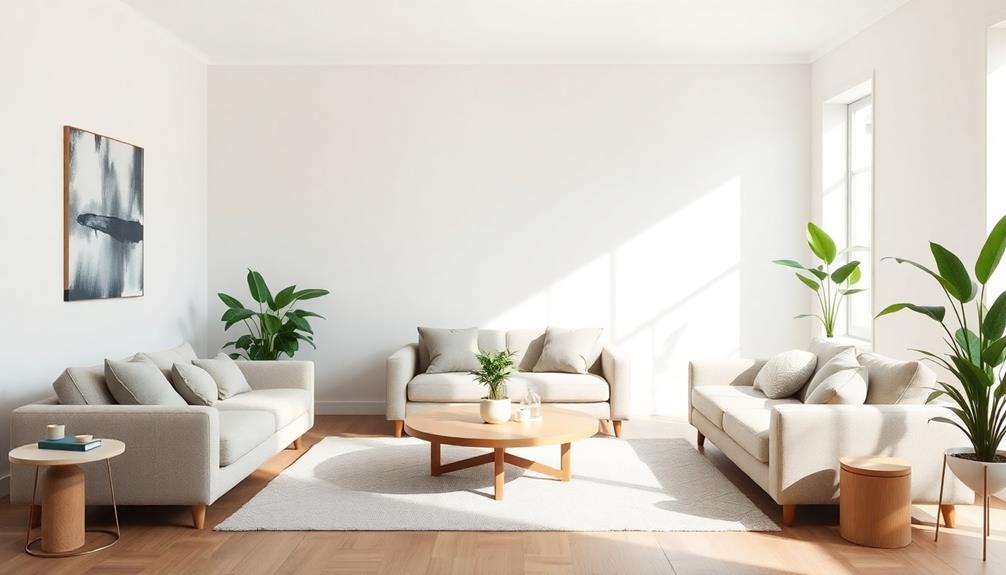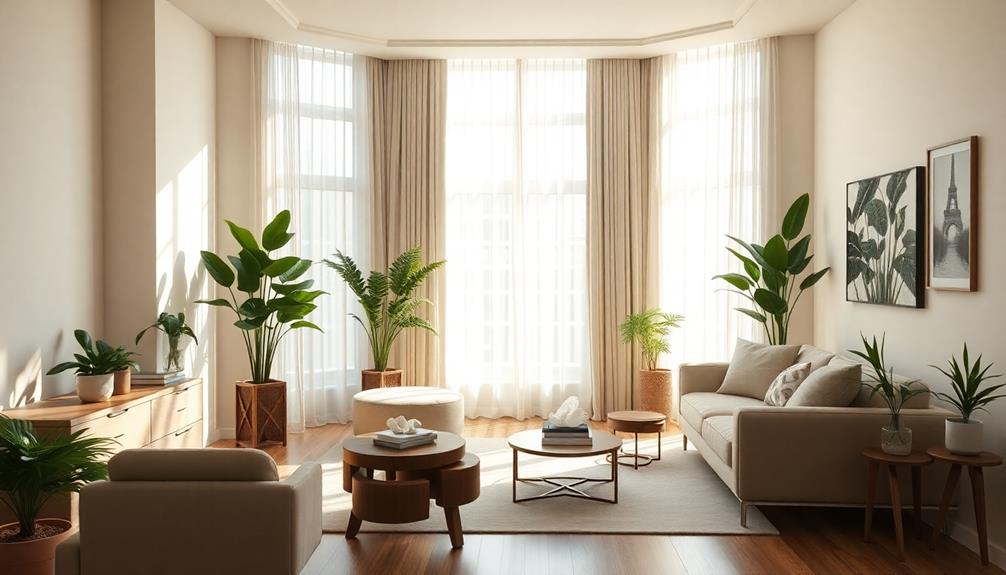Eating alone can dramatically impact your mental health, increasing the risk of depression by 1.42 times. In contrast, dining with others boosts happiness and life satisfaction. Sharing meals creates connections, reduces feelings of isolation, and fosters a sense of community. While you might enjoy solitary meals, they can lead to lower nutritional quality and poor emotional health. Even though many people eat alone, most prefer the experience of sharing meals. Understanding these dynamics can enhance your dining choices and emotional well-being. Keep exploring to discover ways to improve your dining experiences and social interactions.
Key Takeaways
- Eating with others enhances happiness and reduces feelings of loneliness, improving overall mental health.
- Solitary dining is linked to a higher risk of depression and poorer nutritional quality.
- Regular shared meals strengthen community ties and promote emotional well-being.
- Social dynamics during group meals can lead to increased food intake and mindful eating behavior.
- Cultural backgrounds and demographics significantly influence attitudes towards solo vs. communal eating.
Social Eating and Happiness
When you share a meal with others, the experience often boosts your happiness and overall life satisfaction. Social eating plays a critical role in enhancing your mental health, as research shows that those who dine with others report higher levels of joy and fulfillment.
Enjoying classic dishes like squash casserole or fried pork chops during communal meals can further enhance these positive feelings, as food often serves as a catalyst for conversation and connection. Communal meals create an opportunity for connection, which can greatly reduce feelings of loneliness and isolation.
While about 57% of people regularly share evening meals, nearly 20% consider communal dining a rare occurrence. This highlights a need for more social dining opportunities. Eating alone, on the other hand, is linked to higher rates of depression and suicidal thoughts, making it clear that enjoying meals in solitude can negatively affect your emotional well-being.
Individuals who dine solo have 1.42 times greater odds of experiencing depressive symptoms.
Initiatives like The Big Lunch aim to unite communities through shared dining experiences, emphasizing the importance of these gatherings for fostering relationships.
With 75% of participants believing that communal meals strengthen community bonds, it's evident that social eating isn't just about food; it's about enhancing happiness and life satisfaction through meaningful connections.
Trends in Dining Habits
You might notice that many people are eating alone more often, with a significant portion of meals consumed in isolation during the week.
This shift can be particularly pronounced during the spring months, when seasonal ingredients like fresh nettles are at their peak, making dishes such as Nettle and Potato Soup a missed opportunity for shared culinary experiences.
While communal dining seems appealing, statistics show that shared meals are becoming a rarity in our daily lives.
This trend raises questions about the impact of isolation on our well-being and community connections.
Isolation in Meal Times
How has the trend of eating alone changed our social interactions? The rise in solitary meal practices has profound implications for our mental well-being and community connections. With a third of weekday evening meals consumed in isolation, it's clear that many of us face increasing loneliness. The lack of communal dining experiences contributes to social anxiety and feelings of isolation. Sharing meals, such as enjoying a plate of Mushroom Masala or a flavorful Kathi Roll, can foster connections and enhance the dining experience.
Consider these statistics:
- 69% of individuals report never sharing a meal with their neighbors.
- Nearly 20% see communal dining as a rare occurrence.
- 21% of individuals eat at different times than household members.
These figures reveal a troubling trend: shared meals are becoming increasingly uncommon. For older adults (55+), the impact is especially severe, as 25% report infrequent shared meals, intensifying feelings of loneliness.
This shift towards eating alone not only affects individual mental health but also erodes community bonds. As we prioritize solitary dining, we risk losing opportunities for connection, support, and shared experiences that enrich our lives. Recognizing these changes is essential for fostering healthier social interactions and combating the isolation that many face during meal times.
Community Dining Preferences
As solitary dining becomes more common, many are re-evaluating their community dining preferences. While a third of weekday evening meals are consumed alone, you might find it surprising that 57% of people still enjoy sharing meals with others. This reflects a strong desire for communal dining, even as social eating habits shift.
The table below highlights key trends in community dining preferences:
| Dining Aspect | Statistics | Notes |
|---|---|---|
| Frequency of Eating Alone | 10 out of 21 meals | Average adult's solitary meals weekly |
| Shared Meals with Neighbors | 69% never share | Indicates a lack of local community |
| Dining with Community Groups | 37% infrequent | Many haven't dined in groups lately |
| Older Adults Dining Alone | 25% infrequent meals | Shows a generational gap in habits |
Despite nearly 20% viewing communal dining as rare, the benefits of sharing food with others can't be overlooked. Regular social eating can help combat health problems linked to isolation. By exploring your own dining habits, you might discover new opportunities to enjoy meals with others.
Frequency of Shared Meals
Recent statistics reveal that shared meals are becoming less frequent, with a significant portion of the population opting for solitary dining. In fact, many adults are now eating alone more often than ever. Consider these trends in dining habits:
- Solitary Meals: A third of weekday evening meals are consumed in isolation, with the average adult eating 10 out of 21 meals alone each week. This shift may lead to a greater appreciation for meals that bring people together, such as those featuring Turkey Sandwiches made from Thanksgiving leftovers.
- Communal Dining: Nearly 20% of individuals consider communal dining a rare occurrence, indicating a shift away from social eating.
- Older Adults: About 25% of older adults (55+) report infrequent shared meals, further emphasizing the isolation experienced by this demographic.
While 57% of respondents still share evening meals, one in eight haven't shared lunch with friends or family in over six months. Additionally, a striking 69% have never shared a meal with their neighbors.
This decline in shared meals can lead to feelings of isolation and may negatively impact mental health. Understanding these trends is vital as we navigate the psychological effects of eating alone versus in groups. Engaging in shared meals could foster connection and improve overall well-being.
Shared Meals and Frequency
Sharing meals with others plays an essential role in our social lives, yet many people still find themselves dining alone more often than they'd like. Research shows that while 57% of individuals regularly enjoy evening meals with others, nearly 20% consider communal eating a rarity. A significant portion, about one-third, of weekday evening meals are consumed in isolation.
Here's a glimpse into the frequency of shared meals versus solitary dining:
| Frequency of Meals | Percentage of People |
|---|---|
| Regularly share meals | 57% |
| Rarely share communal meals | 20% |
| Eat alone during weekdays | 33% |
| Older adults dining alone | 25% |
| Average meals eaten alone | 10 out of 21 |
This trend highlights how many people eating alone struggle to engage in social bonding through shared meals. The Big Lunch initiative aims to combat this by encouraging communal dining events, emphasizing the importance of eating together to foster connections and combat loneliness. By increasing the frequency of shared meals, you can enhance your social well-being and create stronger relationships.
Community Importance
Eating together isn't just about sharing food; it's an essential way to strengthen social bonds. When you gather around a table, you're not only enjoying a meal but also reducing feelings of loneliness that can creep in when you dine alone.
For instance, sharing a classic dish like a Loaded Baked Potato can create a comforting atmosphere that encourages conversation and connection. By embracing communal meals, you help foster a sense of community that benefits everyone involved.
Social Bonds Strengthening
Throughout history, communal meals have played an essential role in strengthening social bonds within communities. When people gather around the table, they create connections that enhance emotional well-being and reduce feelings of loneliness.
Research shows that 75% of individuals believe shared meals strengthen community ties, a demonstration to the power of communal eating. The act of sharing food, such as traditional dishes like Caldeirada or desserts like Brigadeiro, can foster a sense of togetherness and cultural appreciation among participants.
Here are three key benefits of shared meals in fostering social bonds:
- Increased Life Satisfaction: Participants who regularly share meals report higher levels of happiness and fulfillment.
- Community Engagement: Initiatives like The Big Lunch have united over 7.3 million people, showcasing the importance of eating together to build community.
- Support for Vulnerable Groups: Older adults, often dining alone, can benefit greatly from joining in communal dining practices, enhancing their social networks.
Reducing Loneliness Effects
Communal meals play an essential role in reducing loneliness and fostering a sense of belonging within communities. Research shows that social eating markedly enhances your well-being, with 75% of participants believing shared meals strengthen community ties.
Traditional Indonesian dishes like Kue Putu create a warm atmosphere during gatherings, encouraging neighborly connections through communal eating. Initiatives like The Big Lunch have organized over 90,000 events in the UK to combat loneliness, encouraging neighborly connections through communal eating.
When you eat alone, you might face higher rates of depression and suicidal thoughts. Studies reveal that those who dine solo have 1.42 times higher odds of experiencing depression than those who share meals. Alarmingly, a third of weekday evening meals are consumed in isolation, a concerning trend that exacerbates loneliness and mental health issues.
Regularly sharing meals, even just once a week, can make a notable difference. It combats feelings of loneliness and enhances emotional health.
Social eating helps you build strong social bonds and emotional support networks. By participating in shared meals, you not only nourish your body but also strengthen your connections with others, ultimately reducing the impact of loneliness in your life.
Embrace communal eating, and watch your emotional landscape shift for the better.
Mental Health Implications
Isolation during meals can greatly impact mental health, leading to increased feelings of depression and loneliness. Research shows that eating alone is linked to a 1.42 times higher risk of depression and a 1.49 times higher risk of suicidal ideation, particularly in younger adults.
When you dine alone, your life satisfaction may drop considerably, as communal meals provide emotional support and enhance wellbeing. In many cultures, such as the communal dining practices seen in dishes like Muamba De Galinha, shared meals create bonds and foster a sense of belonging. These traditional meals often play a crucial role in cultural celebrations, further emphasizing the importance of eating together.
Here are three key implications of eating alone on your mental health:
- Increased Depression: Individuals who frequently eat alone often report higher rates of depressive symptoms compared to those who share meals.
- Lower Life Satisfaction: Eating alone can lead to feelings of isolation, which negatively impacts your overall sense of happiness and fulfillment.
- Weakened Social Ties: Social eating fosters connections; about 75% of participants believe shared meals strengthen community ties, helping to combat loneliness.
Promoting communal meals through public health initiatives can serve as a preventive measure against these mental health issues, especially for vulnerable populations. Engaging in social eating can be a simple yet effective way to enhance your mental wellbeing.
Psychological Mechanisms of Eating
When you share a meal with others, the psychological mechanisms at play can considerably influence your eating behavior. Social eating tends to boost your food intake, as you often consume more calories in a group setting. This phenomenon occurs due to social facilitation, where the presence of others can lead you to eat more than you'd alone.
For instance, festive gatherings featuring delicious dishes like Graveyard Taco Dip can enhance the overall enjoyment and encourage more substantial eating. Emotional states and the dynamics of your group matter too; you might find yourself matching the consumption levels of your peers to avoid any social embarrassment.
Research shows that larger groups can further amplify this effect, as individuals are influenced by the eating behaviors of those around them, leading to overindulgence.
On the flip side, if you're a solo diner, you might face higher rates of depression and unhealthy eating habits. Eating alone is often linked to lower nutritional quality and poorer health outcomes.
This disparity highlights how eating with others can't only enhance your enjoyment of food but also impact your overall well-being. Understanding these psychological mechanisms can help you make more mindful choices about your dining experiences.
Factors Influencing Eating Behavior
How do the circumstances surrounding a meal shape what and how much you eat? The setting in which you eat plays a significant role in your eating behavior.
When you engage in social eating or communal eating, several factors come into play that can influence your food intake:
- Group Size: Larger groups often lead to increased consumption. As the number of diners grows, so does the amount of food ordered and shared, resulting in higher overall intake. For example, sharing dishes like chilaquiles or quesadillas can enhance the communal experience and encourage more food consumption.
- Social Dynamics: You might find yourself matching the consumption levels of your peers. This tendency to overindulge during communal meals stems from the social facilitation effect, where your eating behavior aligns with those around you.
- Distraction and Engagement: During group meals, social interactions can divert your attention from food. This distraction might lead to overeating without you even realizing it.
Understanding these factors can help you make more mindful choices about your eating behavior.
Future Research Directions
As researchers explore deeper into the psychological effects of dining alone versus in groups, establishing causal relationships between solo dining and mental health outcomes becomes vital. Current studies mainly highlight correlations, so it's important to conduct longitudinal studies that assess how social eating impacts your emotional well-being over time.
Additionally, investigating virtual dining experiences could shed light on how modern trends influence social interaction and mental health, especially as digital communication grows. Researchers should consider how different cultural contexts and demographics shape attitudes towards solo versus communal eating, revealing valuable insights into varying social environments.
Interventions that promote positive perceptions of solo dining are also needed. By developing strategies that enhance communal eating opportunities, you can potentially improve mental health outcomes for individuals who feel isolated during meals.
Future research should focus on these areas to create a more thorough understanding of how dining contexts affect psychological well-being. In doing so, you'll contribute to a more nuanced discourse surrounding social eating and its implications for mental health, ultimately fostering healthier eating habits and emotional resilience in diverse populations.
Frequently Asked Questions
What Is the Psychology Behind Eating Alone?
When you eat alone, you often experience isolation, which can affect your mood and overall well-being. Eating solo may lead to negative thoughts, impacting your self-esteem and increasing feelings of loneliness and disconnection from others.
Is Eating Alone Good for Your Mental Health?
Did you know that eating alone raises your odds of depression by 1.42 times? While solitude can offer peace, regularly dining solo might negatively impact your mental health and emotional well-being. Consider sharing meals instead.
Is It Better to Eat Alone or With Others?
You'll find that sharing meals with others often brings more joy and connection. Eating together fosters relationships and creates a sense of community, making it a more enriching experience than dining alone.
What Are the Side Effects of Eating Alone?
Eating alone can lead to feelings of loneliness and sadness. You might find your nutritional choices suffer, opting for quick, unhealthy meals. Over time, these patterns can impact your mental and physical health negatively.
Conclusion
Eating alone can feel like a solitary ship adrift in a vast ocean, while sharing meals with others transforms that vessel into a vibrant fleet, sailing together toward happiness. The warmth of communal dining nurtures bonds and enriches our mental well-being, reminding us that food is more than sustenance—it's a bridge to connection. As you navigate your dining choices, remember the power of shared moments; they can illuminate your journey and anchor your spirit in a world that often feels isolated.









